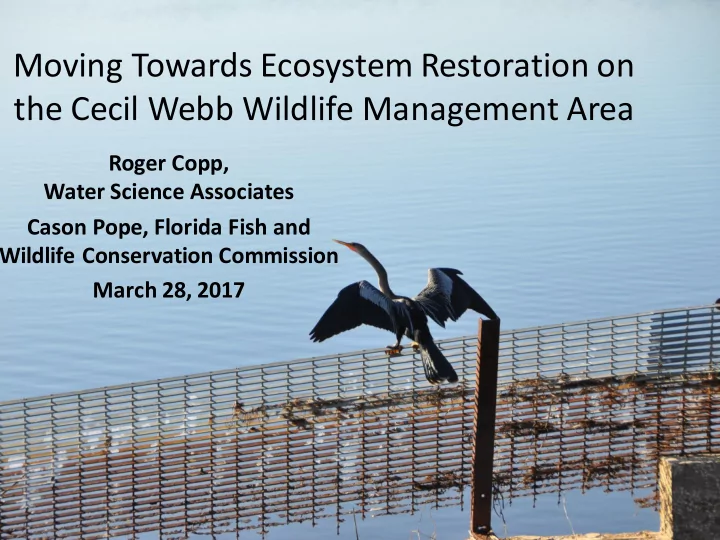

Moving Towards Ecosystem Restoration on the Cecil Webb Wildlife Management Area Roger Copp, Water Science Associates Cason Pope, Florida Fish and Wildlife Conservation Commission March 28, 2017
Study Area and Flow Pathways
Problems • Too much water in southwest Cecil Webb WMA • Restricted flows under I-75 due to lands on both sides of I-75 that have berms which have reduced flows to much lower levels • Historic flow-ways have been blocked. • Hydroperiod is too short in Yucca Pens Unit West of U.S. 41 What Do We Need? • Storage area for excess water from SW Cecil Webb WMA • Flow-way from Cecil Webb across private lands between I-75 and Yucca Pens
Opportunities • Farm blocking flow from Cecil Webb was available for purchase (and was purchased) that can be use to store water • FDOT needed a solution to a multi-million dollar stormwater management challenge in widening I-75 • If all could cooperate, the farm could be their stormwater management system • Buying the farm reduces nutrient loads and peak flows to the Caloosahatchee River estuary • Lands west of I-75 could potentially benefit from cooperating with the project
First, We Needed More Data Thanks, FDOT, USGS, & FWC!
Constrictions Along I-75 North of Lee County Line
Railroad Constrictions This culvert has flow Largest Capacities at 6, 7, and 8
Railroad Culvert # 17 - Only Culvert That Flows 30” diameter
Wetlands West of RR #17 Constrict Flows
Railroad Trestle Bridge #8 – No Flow Inv. = 21.3 ft-NAVD
Berm Around McNew Property
Railroad Trestle Bridge #7 – No Flow
Topo in Vicinity of FDOT Br #7 There is an opening at #7, but there is no where for the water to go
Surveying of Additional Cross Sections was conducted
Status of Work to Date • Major hydraulic features have been added to model • Added more recent rainfall to coincide with newly collected stage data in WMA • Model calibrated and used for I-75 Widening Permit • Proposed conditions simulations have been conducted • Portions of project are in advanced stages of evaluation • Bond Property being designed for water storage
Original Concept
Proposed Wetland Mitigation Area Elevation % of Site < 23 ft-NAVD 4 23 – 24 ft 40 24 – 25 ft 44 25 – 26 ft 11 > 26 ft 1 The existing site is a farm used for cattle grazing. An existing pump station at the south end of the site discharges stormwater to Gator Slough
Photos of Mitigation Site – Existing Condition 2012, pump on 2013, pump off Ground elevation = 23.7 ft-NAVD The farm is maintained in a dry condition for cattle grazing. The site becomes very wet if the pumps are turned off
Other Components of Plan SW Aggregate Mine is another place to store water and/or provide a pathway Landfill property west of US 41 has wetlands that could be part of the conveyance to Yucca Pens Potential Flow-way through McNew Property
Ecologic Assessment • Assessment focused on SW portion of Cecil Webb WMA • Field work was conducted in Sept 2014 • Biological indicators were used to evaluate habitat condition • Hydraulic modeling was conducted to evaluate restoration • Combined info used to determine mitigation potential Large Area in Cecil Webb will benefit from the project
Simulated Response in Cecil Webb WMA Simulated Water Levels, SW Cecil Webb WMA 27.5 27 July 1 - Oct 31 Wet Season Water Level Drop = 1.5 ft 26.5 26 ft-NAVD 25.5 25 24.5 24 23.5 23 1/1/12 3/1/12 4/30/12 6/29/12 8/28/12 10/27/12 12/26/12 Ground Elevation, Oak Hammock Ground Elevation, Marsh Existing Proposed Results assume additional storage area is utilized beyond Bond Water Storage Facility.
Benefits of Project • Purchase of the Bond Farm is the most critical component of the Cecil Webb/Yucca Pens ecosystem restoration effort. Purchasing the farm will improve hunting habitat in both WMAs • Reduces nutrient loads and wet season freshwater flows to estuarine waters • Reduces wetland impact and the cost of widening I-75 between Tuckers Grade and the Charlotte/Lee County line • Reduces the wetland impact of the I-75 widening project • Increases the potential of creating a water supply reservoir for the City of Cape Coral. Cape Coral needs additional water so that the City can continue to develop .
Why this Project Has Been Successful • Charlotte Flatwoods Initiative is a widely represented stakeholder group that has worked together to achieve project objectives. Key partners: – SFWMD – Florida Fish and Wildlife Conservation Commission (FWC) – FDOT – USGS – Charlotte Harbor National Estuary Program – SWFWMD – FDEP – Charlotte and Lee Counties – City of Cape Coral
Next Steps • Complete design of Bond Property • Secure funds for construction of water storage facility on Bond Property • Work is underway to evaluate Southwest Aggregates property to store additional excess water from Cecil Webb WMA • Conduct additional ecologic studies of Cecil Webb and Yucca Pens to determine hydroperiod needs for both WMAs • Continue to identify win-win-win solutions with partners to achieve common goals • Additional modeling analysis, preliminary design, obtaining funds, final design, and permitting
Recommend
More recommend